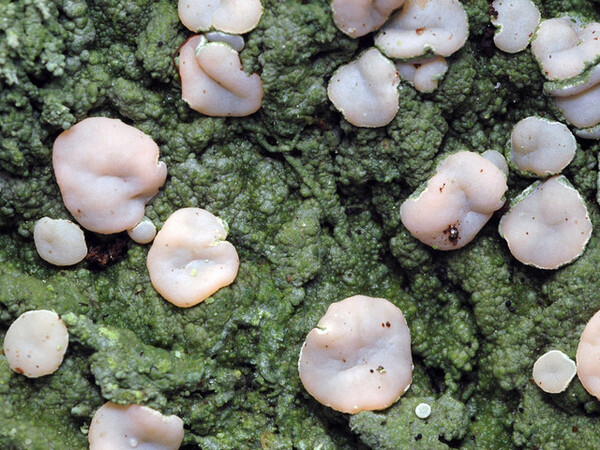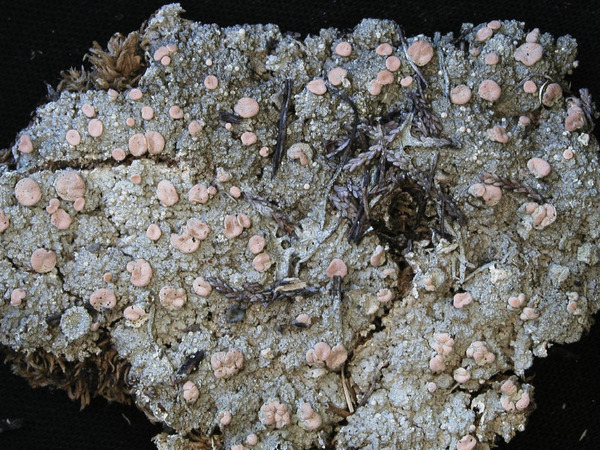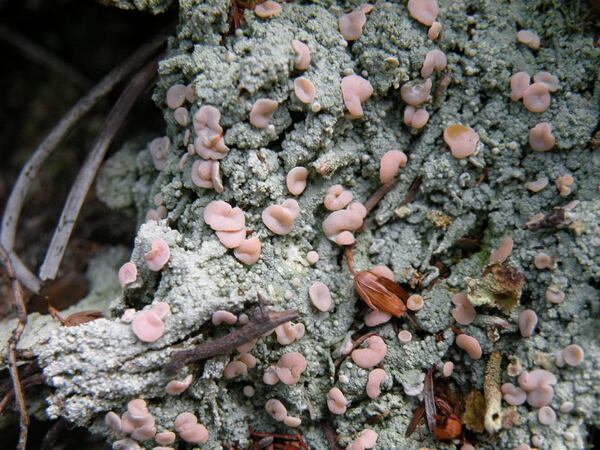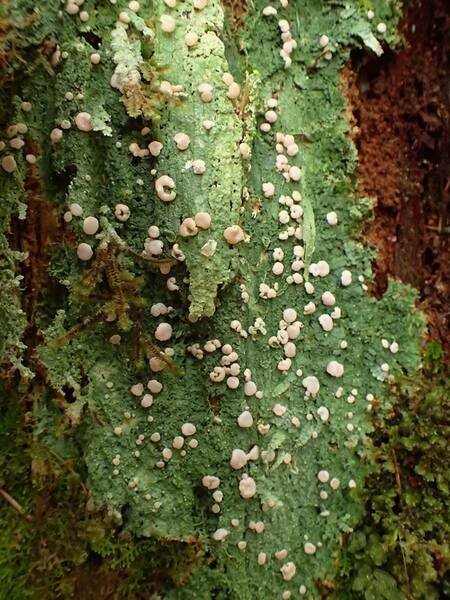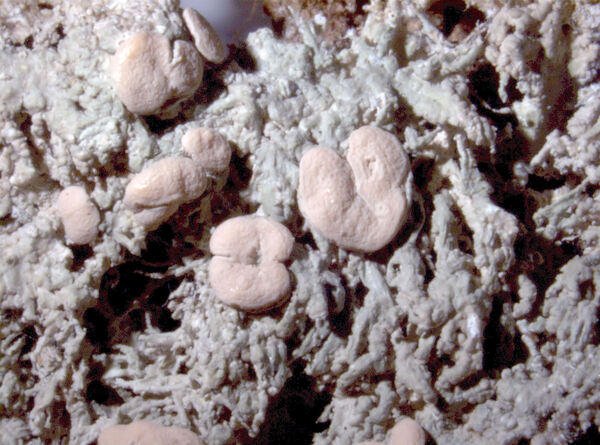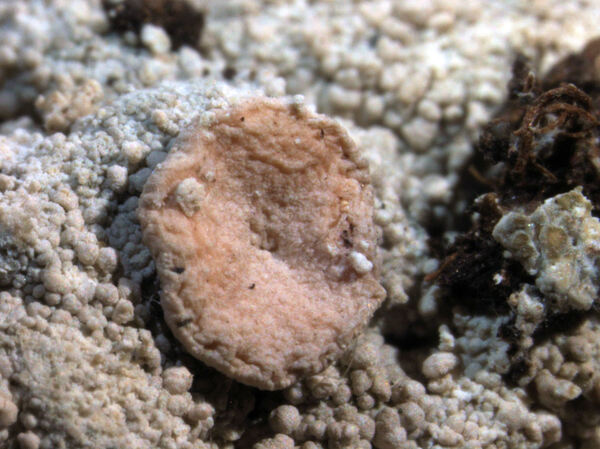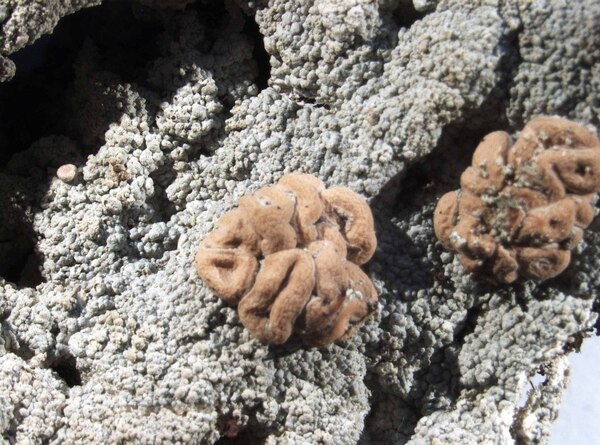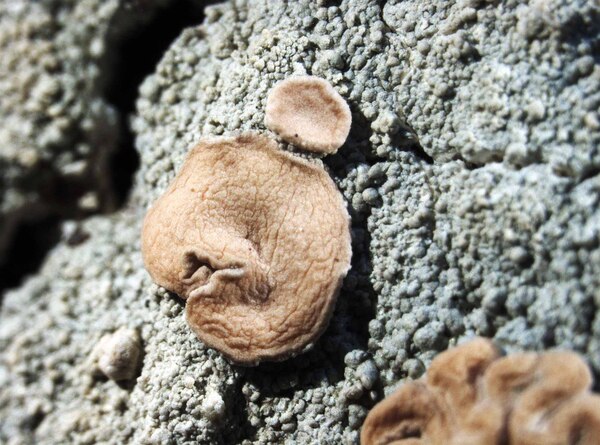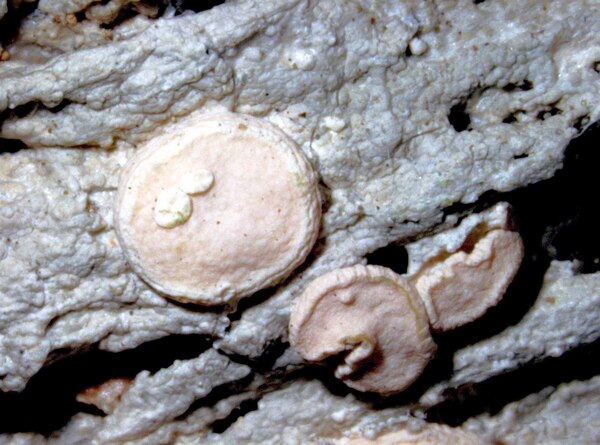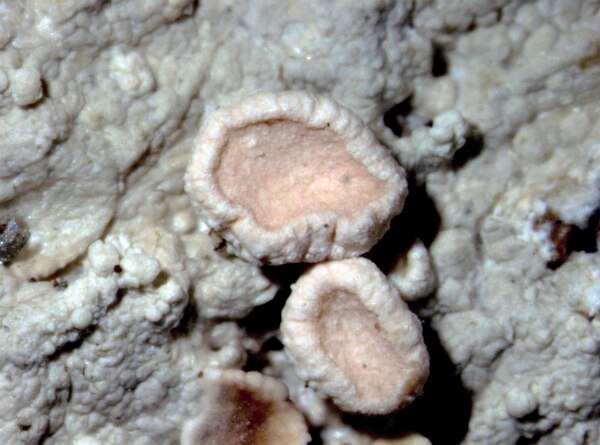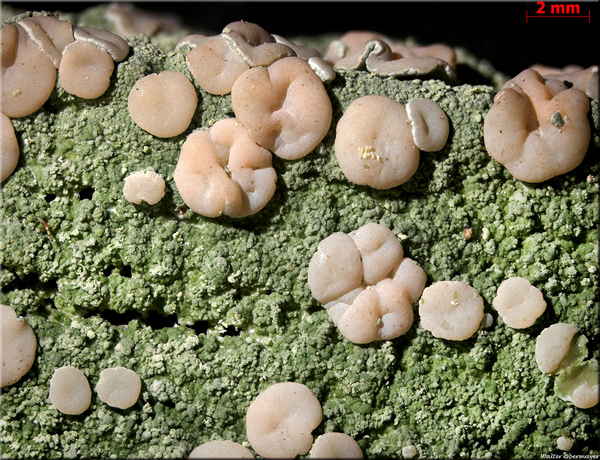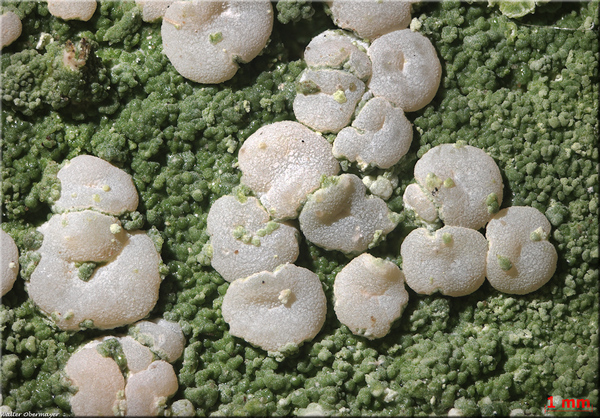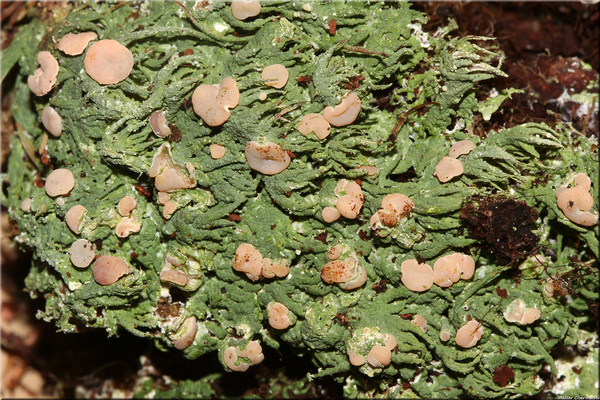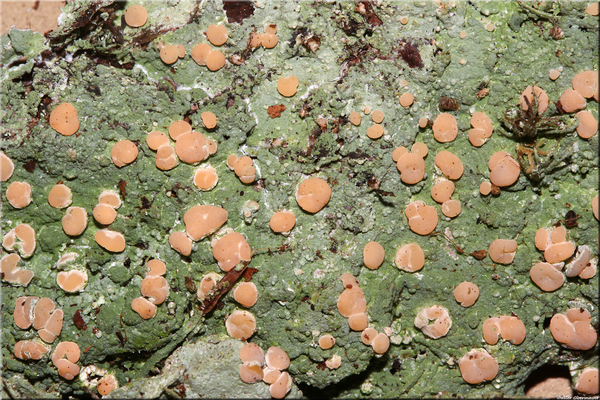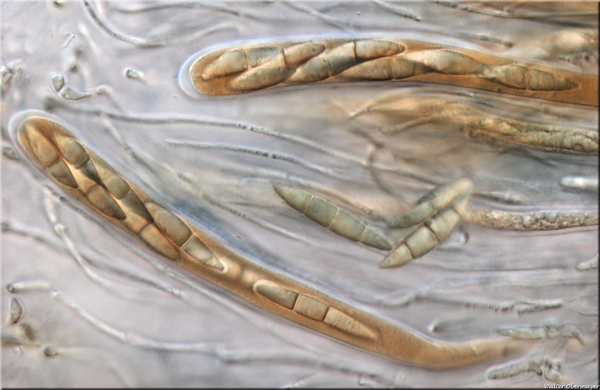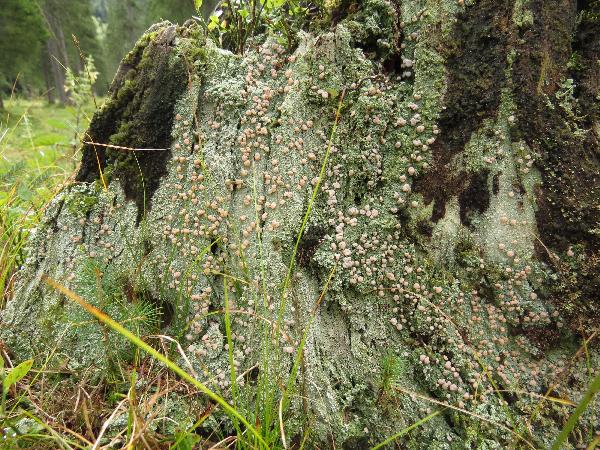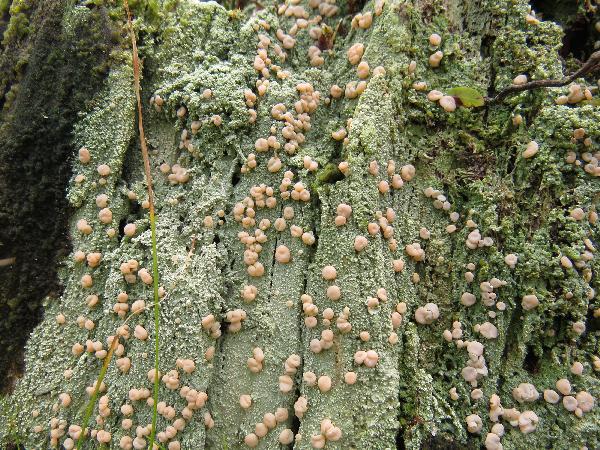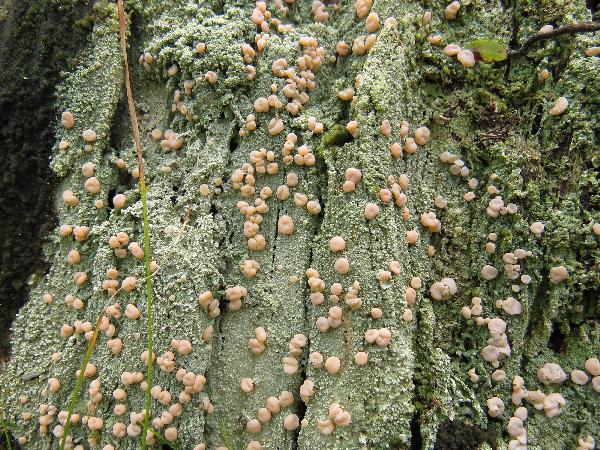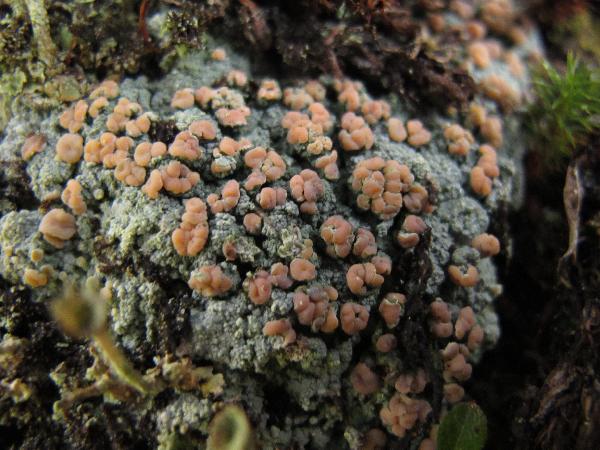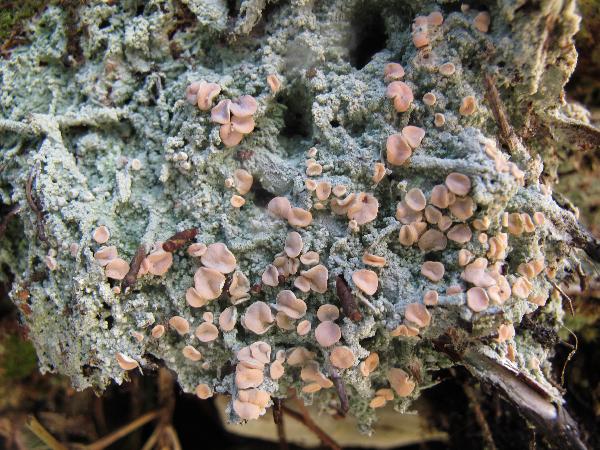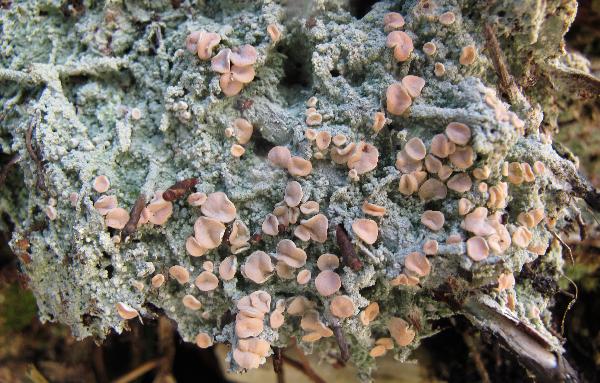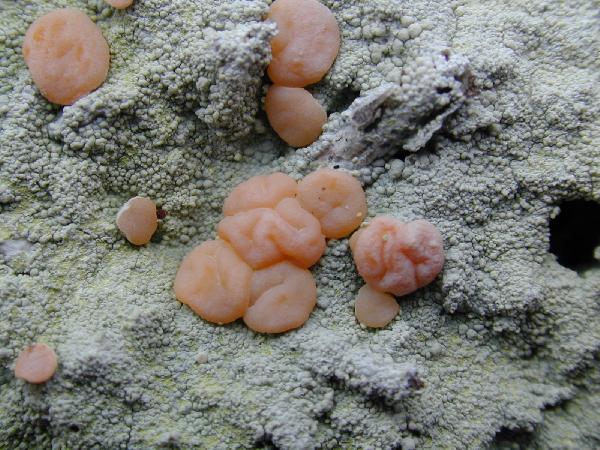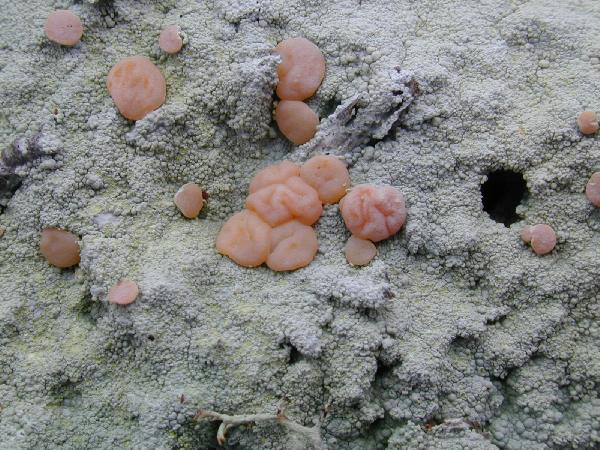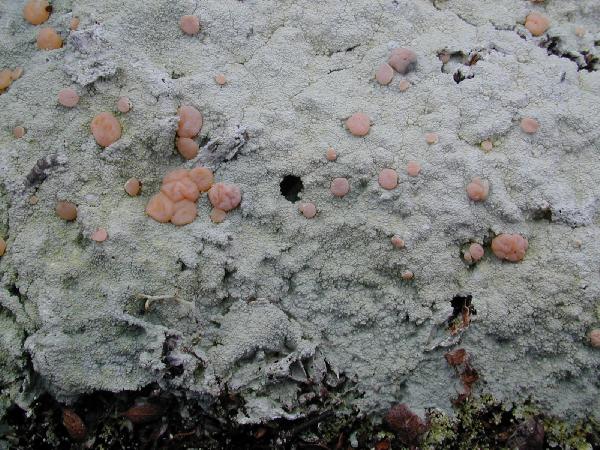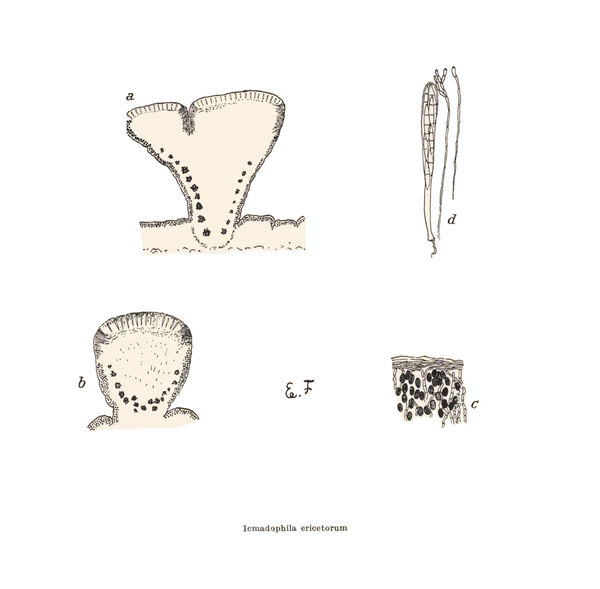Icmadophila ericetorum (L.) Zahlbr.
Wiss. Mitt. Bosn. Herzeg., 3: 605, 1895. Basionym: Lichen ericetorum L. - Sp. Pl.: 1141, 1753.
Synonyms: Baeomyces aeruginosus (Scop.) DC.; Baeomyces icmadophilus (L. f.) Bory; Biatora icmadophila (L. f.) Fr.; Icmadophila aeruginosa (Scop.) Trevis.; Icmadophila aeruginosa var. teretocarpa A. Massal.; Icmadophila elveloides (Weber) Hedl.; Lecidea icmadophila (L. f.) Ach.; Patellaria aeruginosa (Scop.) Spreng.
Distribution: N - Frl (Tretiach & Hafellner 2000), Ven (Nimis 1994, Nascimbene & Caniglia 1997, 2003c, Caniglia & al. 1999, Lazzarin 2000b, Nascimbene 2011), TAA (Caniglia & al. 2002, Nascimbene 2005b, 2006c, 2008b, Nascimbene & al. 2005, 2006, 2007b, 2008c, 2022, Lang 2009), Lomb, Piem (Isocrono & al. 2004, 2006), VA (Piervittori & Isocrono 1999), Emil (Fariselli & al. 2020), Lig (Brunialti & al. 1999). C - Tosc, Sar.
Description: Thallus crustose, episubstratic, pale green, glaucous green or whitish grey, brighter green when wet, continuous, consisting of a soft layer of 100-300 µm thick, ecorticate, soredia-like to wart-like granules. Apothecia biatorine, round to irregular in outline, strongly constricted to substipitate, 1-2(-3.5) mm across, with a flesh-coloured to pale orange-pink, sometimes faintly white-pruinose, smooth to finally wrinkled, flat to convex disc, and a thin, smooth, sometimes irregularly lobulate, often paler, sometimes whitish-pruinose, finally often excluded proper margin. Proper exciple of intricately interwoven hyphae, extending below the hymenium; epithecium reddish brown, with many small crystals, K+ orange-red; hymenium colourless, 120-160 µm high, I+ blue; paraphyses simple or sparingly branched in upper part, slender, c. 1 μm thick at mid-level, the apical cells swollen, up to 5 μm wide; hypothecium colourless, the central part with colourless crystals not dissolving in K. Asci (6-)8-spored, narrowly cylindrical, K/I- except for a thin K/I+ dark blue cap in the apical wall, Icmadophila-type. Ascospores 1(-3)-septate, hyaline, fusiform-elongate, 12-28(-30) x 4-6(-7) μm. Pycnidia pale, immersed, with a colourless wall, the conidiogenous cells enteroblastic, short-cylindrical. Conidia simple, hyaline, bacilliform, 3.5-4.5 x 0.5-1 μm. Photobiont chlorococcoid (Coccomyxa), the cells ellipsoid, 5-8 x 3-4 µm, with a large parietal chloroplast, surrounded by a gelatinous layer. Spot tests: thallus K+ orange turning brownish orange, C-, KC+ orange, P+ orange, UV+ glaucous; apothecia K+ and P+ orange-red, UV-. Chemistry: thallus with thamnolic and perlatolic acid, apothecia with thamnolic acid only.Note: a cool-temperate to boreal-montane, circumpolar species found on decaying wood and muribund bryophytes, usually in upland areas; common in the Alps, rarer on the high Mediterranean mountains.
Growth form: Crustose
Substrata: lignum, soil, terricolous mosses, and plant debris
Photobiont: green algae other than Trentepohlia
Reproductive strategy: mainly sexual
Commonnes-rarity: (info)
Alpine belt: rather rare
Subalpine belt: rather common
Oromediterranean belt: extremely rare
Montane belt: rather common
Submediterranean belt: absent
Padanian area: absent
Humid submediterranean belt: absent
Humid mediterranean belt: absent
Dry mediterranean belt: absent
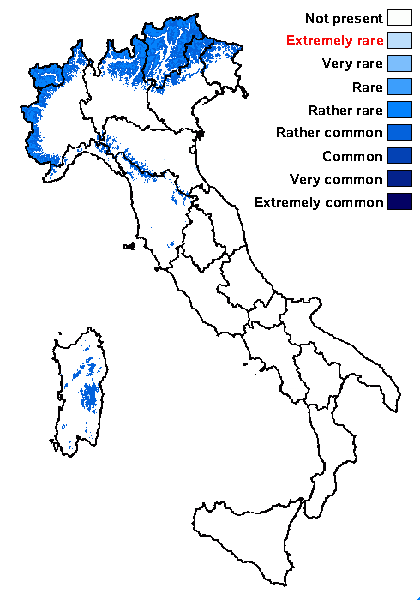
Predictive model
Herbarium samples
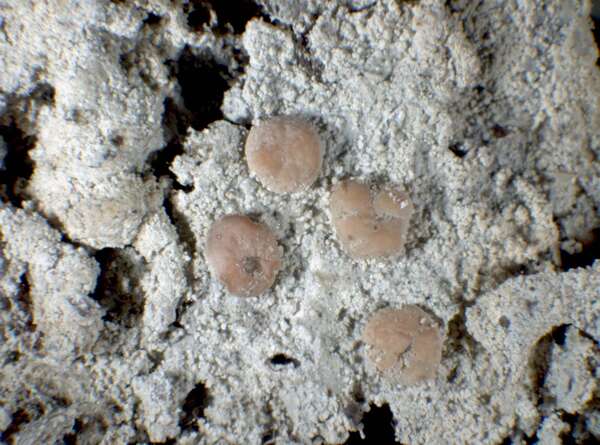

P.L. Nimis; Owner: Department of Life Sciences, University of Trieste
Herbarium: TSB (9037)
2001/11/25
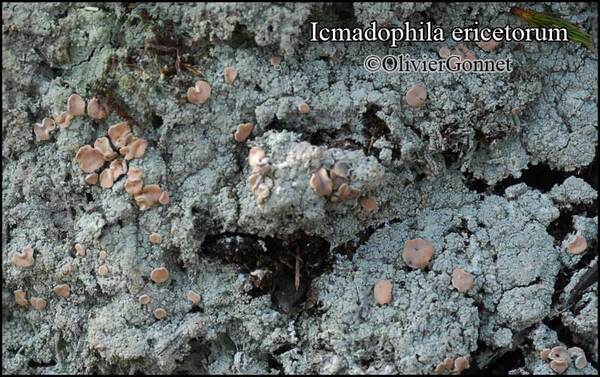
Courtesy Danièle et Olivier Gonnet - Source: https://www.afl-lichenologie.fr/Photos_AFL/Photos_AFL_I/Icmadophila_ericetorum.htm
France, Haute-Savoie 2010
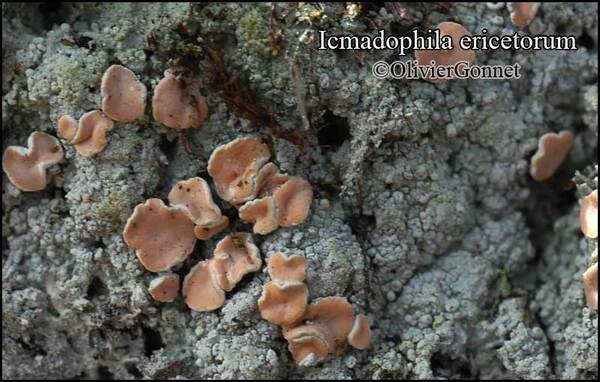
Courtesy Danièle et Olivier Gonnet - Source: https://www.afl-lichenologie.fr/Photos_AFL/Photos_AFL_I/Icmadophila_ericetorum.htm
France, Haute-Savoie 2010

Courtesy Danièle et Olivier Gonnet - Source: https://www.afl-lichenologie.fr/Photos_AFL/Photos_AFL_I/Icmadophila_ericetorum.htm
France, Haute-Savoie 2010
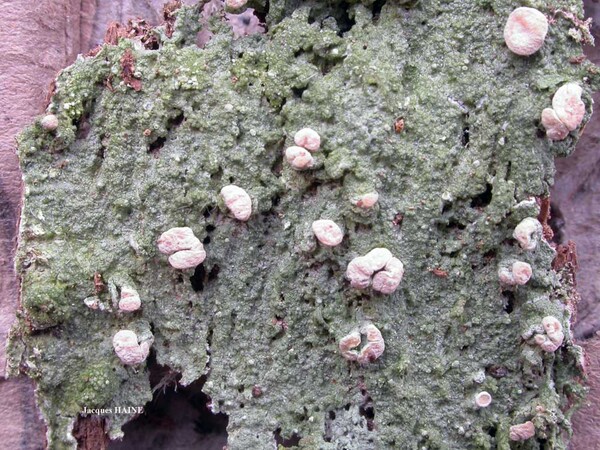
Jacques Haine - Source: http://www.lichensmaritimes.org/index.php?task=fiche&lichen=596&lang=en
France, Jura
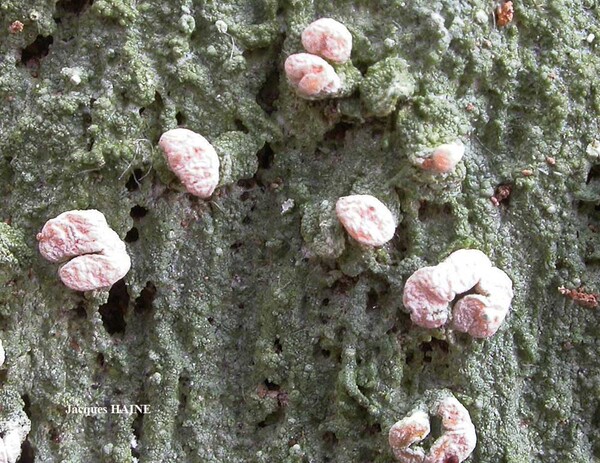
Jacques Haine - Source: http://www.lichensmaritimes.org/index.php?task=fiche&lichen=596&lang=en
France, Jura
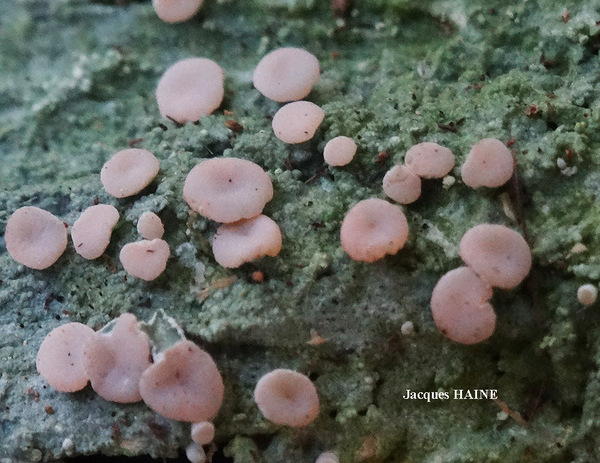
Jacques Haine - Source: http://www.lichensmaritimes.org/index.php?task=fiche&lichen=596&lang=en
France, Jura

Jacques Haine - Source: http://www.lichensmaritimes.org/index.php?task=fiche&lichen=596&lang=en
France, Jura

Jacques Haine - Source: http://www.lichensmaritimes.org/index.php?task=fiche&lichen=596&lang=en
France, Jura

Jacques Haine - Source: http://www.lichensmaritimes.org/index.php?task=fiche&lichen=596&lang=en
France, Jura
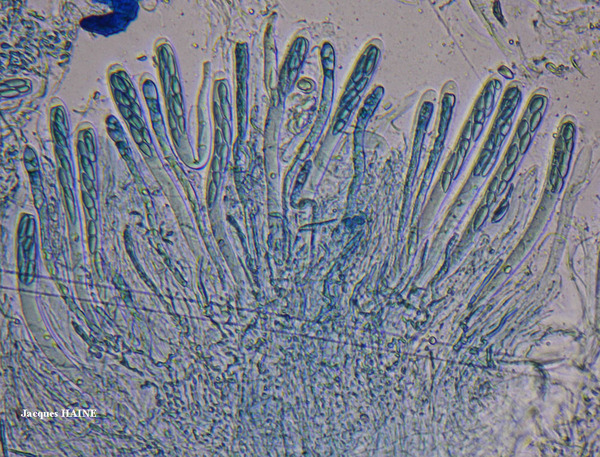
Jacques Haine - Source: http://www.lichensmaritimes.org/index.php?task=fiche&lichen=596&lang=en
France, Jura

Jacques Haine - Source: http://www.lichensmaritimes.org/index.php?task=fiche&lichen=596&lang=en
France, Jura

Jacques Haine - Source: http://www.lichensmaritimes.org/index.php?task=fiche&lichen=596&lang=en
France, Jura
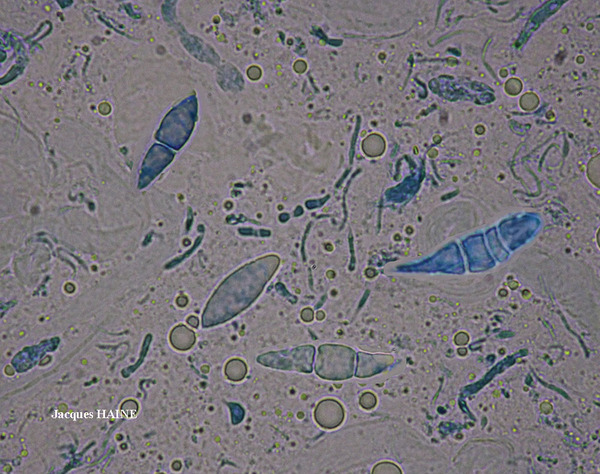
Jacques Haine - Source: http://www.lichensmaritimes.org/index.php?task=fiche&lichen=596&lang=en
France, Jura
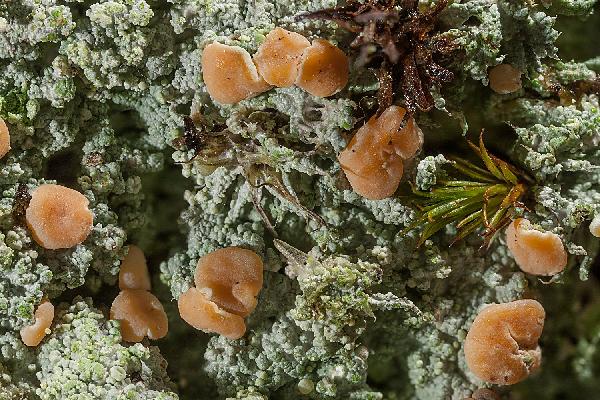
Ulrich Kirschbaum CC BY-SA 4.0 - Source: https://www.thm.de/lse/ulrich-kirschbaum/flechtenbilder
Central Europe; Austria; Tirol: Alps. (Coll/ident. by M. Schessl).
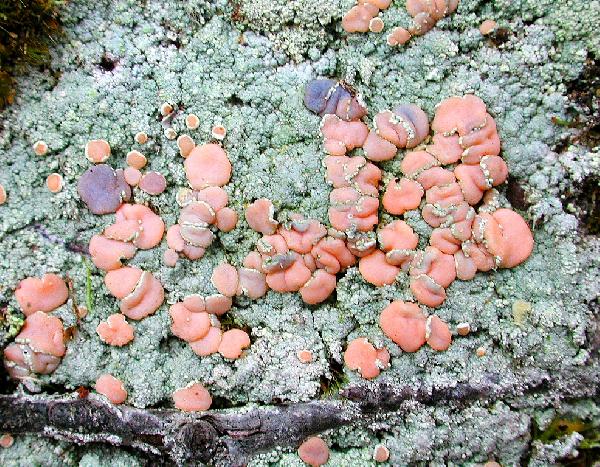
Ulrich Kirschbaum CC BY-SA 4.0 - Source: https://www.thm.de/lse/ulrich-kirschbaum/flechtenbilder
Sweden: Dalarna.

Ulrich Kirschbaum CC BY-SA 4.0 - Source: https://www.thm.de/lse/ulrich-kirschbaum/flechtenbilder
Central Europe; Austria: Alps.
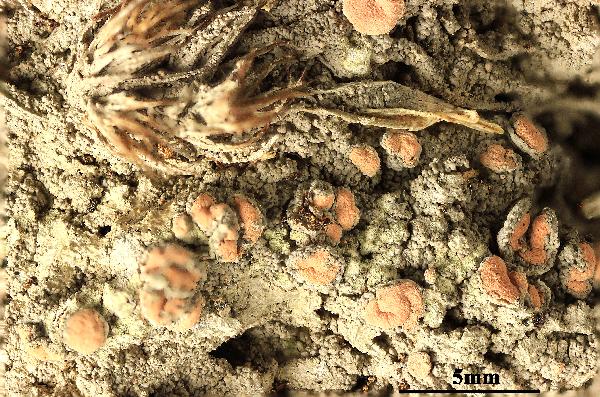

Felix Schumm - CC BY 4.0
[565], Österreich, Land Salzburg, Steir. Salzkammergut, Mitterndorf
bei der Sonnenalm. Leg. D. & F. Schumm, 06.1967, det. F. Schumm.
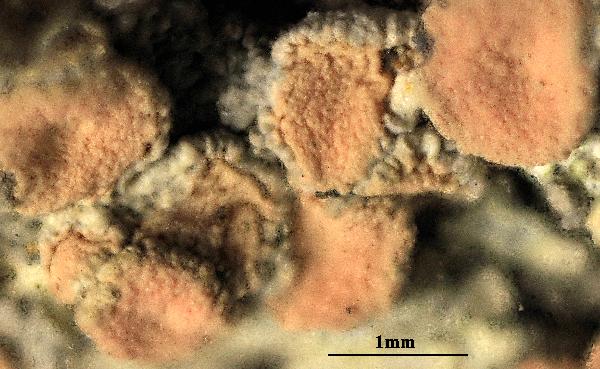

Felix Schumm - CC BY 4.0
[565], Österreich, Land Salzburg, Steir. Salzkammergut, Mitterndorf
bei der Sonnenalm. Leg. D. & F. Schumm, 06.1967, det. F. Schumm.
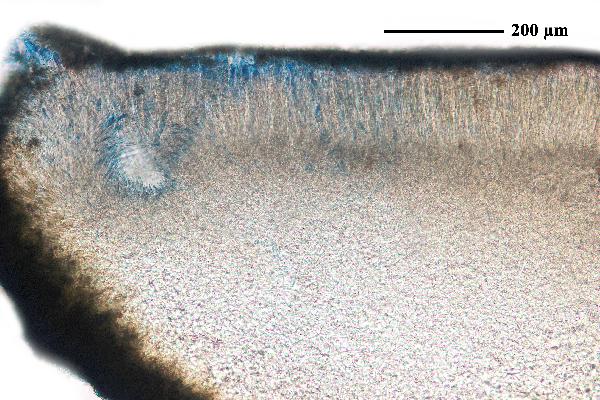

Felix Schumm - CC BY 4.0
[565], Österreich, Land Salzburg, Steir. Salzkammergut, Mitterndorf
bei der Sonnenalm. Leg. D. & F. Schumm, 06.1967, det. F. Schumm.
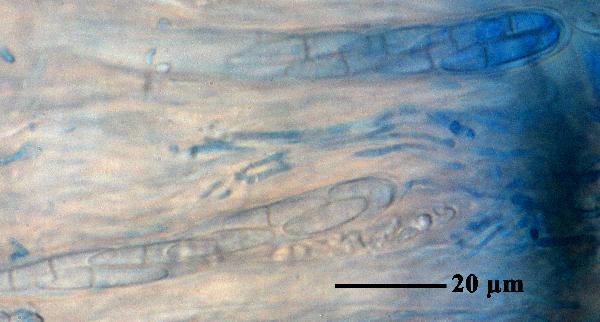

Felix Schumm - CC BY 4.0
[565], Österreich, Land Salzburg, Steir. Salzkammergut, Mitterndorf
bei der Sonnenalm. Leg. D. & F. Schumm, 06.1967, det. F. Schumm.


Felix Schumm - CC BY 4.0
[565], Österreich, Land Salzburg, Steir. Salzkammergut, Mitterndorf
bei der Sonnenalm. Leg. D. & F. Schumm, 06.1967, det. F. Schumm.


Felix Schumm - CC BY 4.0
[565], Österreich, Land Salzburg, Steir. Salzkammergut, Mitterndorf
bei der Sonnenalm. Leg. D. & F. Schumm, 06.1967, det. F. Schumm.
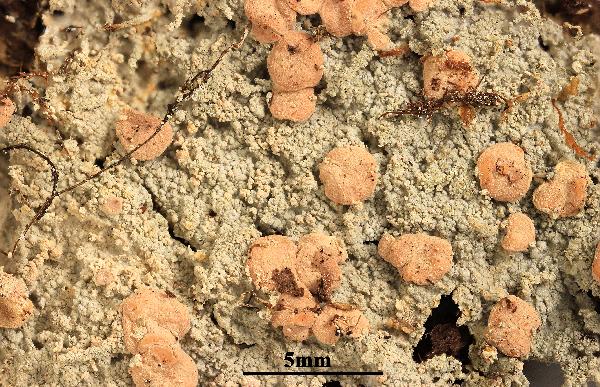

Felix Schumm - CC BY 4.0
[572], Österreich, Land Salzburg, Tennengebirge (bei Bischofshofen),
Anton-Proksch-Haus bei Werfenweng, Ladenberghöhe, ca. 1630 m.
Leg. F. Schumm 24.08.1967. det. F. Schumm, 1967.
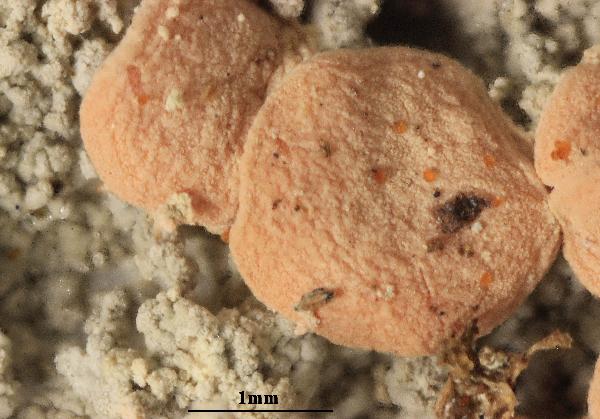

Felix Schumm - CC BY 4.0
[572], Österreich, Land Salzburg, Tennengebirge (bei Bischofshofen),
Anton-Proksch-Haus bei Werfenweng, Ladenberghöhe, ca. 1630 m.
Leg. F. Schumm 24.08.1967. det. F. Schumm, 1967.
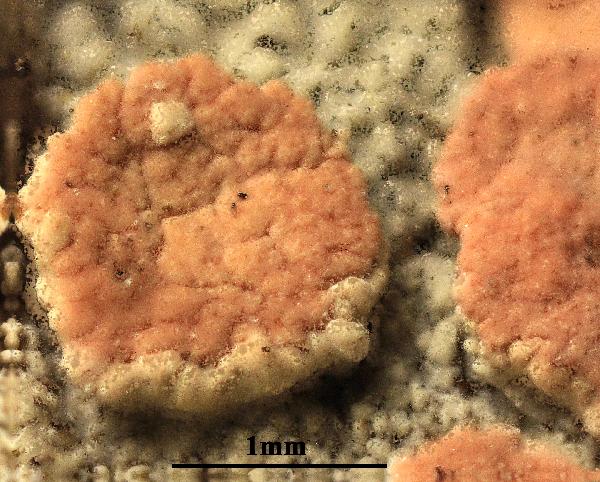

Felix Schumm - CC BY 4.0
[569], Italien, Südtirol, Vigo di Fassa, Vajolettal, bei der Cardeccia
Hütte, 1949 m. Leg. F. Schumm, 06.1963, det. F. Schumm, 1999. -
Sporen 2-4 zellig, hyalin, 20-26 x 4-8 μm.
Growth form: Crustose
Substrata: lignum, soil, terricolous mosses, and plant debris
Photobiont: green algae other than Trentepohlia
Reproductive strategy: mainly sexual
Commonnes-rarity: (info)
Alpine belt: rather rare
Subalpine belt: rather common
Oromediterranean belt: extremely rare
Montane belt: rather common
Submediterranean belt: absent
Padanian area: absent
Humid submediterranean belt: absent
Humid mediterranean belt: absent
Dry mediterranean belt: absent

Predictive model
| Herbarium samples |


P.L. Nimis; Owner: Department of Life Sciences, University of Trieste
Herbarium: TSB (9037)
2001/11/25

Courtesy Danièle et Olivier Gonnet - Source: https://www.afl-lichenologie.fr/Photos_AFL/Photos_AFL_I/Icmadophila_ericetorum.htm
France, Haute-Savoie 2010

Courtesy Danièle et Olivier Gonnet - Source: https://www.afl-lichenologie.fr/Photos_AFL/Photos_AFL_I/Icmadophila_ericetorum.htm
France, Haute-Savoie 2010

Courtesy Danièle et Olivier Gonnet - Source: https://www.afl-lichenologie.fr/Photos_AFL/Photos_AFL_I/Icmadophila_ericetorum.htm
France, Haute-Savoie 2010

Jacques Haine - Source: http://www.lichensmaritimes.org/index.php?task=fiche&lichen=596&lang=en
France, Jura

Jacques Haine - Source: http://www.lichensmaritimes.org/index.php?task=fiche&lichen=596&lang=en
France, Jura

Jacques Haine - Source: http://www.lichensmaritimes.org/index.php?task=fiche&lichen=596&lang=en
France, Jura

Jacques Haine - Source: http://www.lichensmaritimes.org/index.php?task=fiche&lichen=596&lang=en
France, Jura

Jacques Haine - Source: http://www.lichensmaritimes.org/index.php?task=fiche&lichen=596&lang=en
France, Jura

Jacques Haine - Source: http://www.lichensmaritimes.org/index.php?task=fiche&lichen=596&lang=en
France, Jura

Jacques Haine - Source: http://www.lichensmaritimes.org/index.php?task=fiche&lichen=596&lang=en
France, Jura

Jacques Haine - Source: http://www.lichensmaritimes.org/index.php?task=fiche&lichen=596&lang=en
France, Jura

Jacques Haine - Source: http://www.lichensmaritimes.org/index.php?task=fiche&lichen=596&lang=en
France, Jura

Jacques Haine - Source: http://www.lichensmaritimes.org/index.php?task=fiche&lichen=596&lang=en
France, Jura

Ulrich Kirschbaum CC BY-SA 4.0 - Source: https://www.thm.de/lse/ulrich-kirschbaum/flechtenbilder
Central Europe; Austria; Tirol: Alps. (Coll/ident. by M. Schessl).

Ulrich Kirschbaum CC BY-SA 4.0 - Source: https://www.thm.de/lse/ulrich-kirschbaum/flechtenbilder
Sweden: Dalarna.

Ulrich Kirschbaum CC BY-SA 4.0 - Source: https://www.thm.de/lse/ulrich-kirschbaum/flechtenbilder
Central Europe; Austria: Alps.


Felix Schumm - CC BY 4.0
[565], Österreich, Land Salzburg, Steir. Salzkammergut, Mitterndorf bei der Sonnenalm. Leg. D. & F. Schumm, 06.1967, det. F. Schumm.


Felix Schumm - CC BY 4.0
[565], Österreich, Land Salzburg, Steir. Salzkammergut, Mitterndorf bei der Sonnenalm. Leg. D. & F. Schumm, 06.1967, det. F. Schumm.


Felix Schumm - CC BY 4.0
[565], Österreich, Land Salzburg, Steir. Salzkammergut, Mitterndorf bei der Sonnenalm. Leg. D. & F. Schumm, 06.1967, det. F. Schumm.


Felix Schumm - CC BY 4.0
[565], Österreich, Land Salzburg, Steir. Salzkammergut, Mitterndorf bei der Sonnenalm. Leg. D. & F. Schumm, 06.1967, det. F. Schumm.


Felix Schumm - CC BY 4.0
[565], Österreich, Land Salzburg, Steir. Salzkammergut, Mitterndorf bei der Sonnenalm. Leg. D. & F. Schumm, 06.1967, det. F. Schumm.


Felix Schumm - CC BY 4.0
[565], Österreich, Land Salzburg, Steir. Salzkammergut, Mitterndorf bei der Sonnenalm. Leg. D. & F. Schumm, 06.1967, det. F. Schumm.


Felix Schumm - CC BY 4.0
[572], Österreich, Land Salzburg, Tennengebirge (bei Bischofshofen), Anton-Proksch-Haus bei Werfenweng, Ladenberghöhe, ca. 1630 m. Leg. F. Schumm 24.08.1967. det. F. Schumm, 1967.


Felix Schumm - CC BY 4.0
[572], Österreich, Land Salzburg, Tennengebirge (bei Bischofshofen), Anton-Proksch-Haus bei Werfenweng, Ladenberghöhe, ca. 1630 m. Leg. F. Schumm 24.08.1967. det. F. Schumm, 1967.


 INDEX FUNGORUM
INDEX FUNGORUM
 GBIF
GBIF
 DOLICHENS
DOLICHENS
